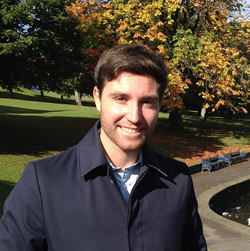Matteo Carpiniello
 Thesis: Bartolomeo Montagna (ca. 1450-1523): Art, Business and Mobility in Renaissance Veneto
Thesis: Bartolomeo Montagna (ca. 1450-1523): Art, Business and Mobility in Renaissance VenetoAbout
After taking two MA degrees in History of Art, one at the University of Pisa and another at the University of Warwick, Matteo is currently in his second year of PhD at the University of Warwick. His PhD research is centred on the art, business and mobility of the Vicentine painter Bartolomeo Montagna (ca. 1450-1523). Matteo was the recipient of a one-year “Master and Back – Alta Formazione 2012” fellowship from the region of Sardinia, Italy (2012-2013). He has been recently awarded a CADRE scholarship that will allow him to fund his doctoral research for the next two and a half years.
Matteo was also the representative of PhD History of Art Students at the University of Warwick (2014-2015).
Research Interests
Artistic exchange, mobility and entrepreneurship in Italian Renaissance art.
Research
My doctoral thesis is concerned with a reappraisal of Bartolomeo Montagna through a meticulous scrutiny of three neglected aspects: the master's landownership and social status, his mobility in the social context of Venice and the terraferma, and his activity as a devotional painter. These topics will be discussed in three parts, preceded by a literature review, alongside the analysis of previous scholars’ methodologies and different approaches to the subject.
The first part stems from the dearth of research on the economic value of Montagna's art and business. Scholarship has hardly ever associated Montagna’s gains from painting with those from landownership. In fact, a close connection between earnings from art and the profits guaranteed by consistently buying and selling real estate is unmistakable in Montagna’s career during the 1480s and 1490s. During these two decades the master seems to have combined his ability and success as a painter with his elevated notion of financing and land transactions. This is without a shadow of a doubt the period in which there is a very fine line between the artist and the businessman. Therefore, this part will be aimed at reconstructing the general investment trends of Montagna’s career, with a particular focus on the interrelation of art and business. This method allows an overview of the evolution of the master’s financial situation, which will take into consideration the agricultural and political transformations of the Venetian terraferma between the fifteenth and sixteenth centuries. Finally, land investments will be described as an indispendable means of fostering Montagna’s standing in the terraferma social fabric.
In the second part, mapping out agrarian investments will be instrumental in reconstructing the geography of Montagna’s land acquisitions, while demonstrating his eagerness to expand his business across as many extra-urban areas of the Vicentino as possible. Moreover, a non-Venetian perspective will be essential to place Montagna within the debate on the role of the periphery in the studies of Renaissance Veneto. In this respect, I shall argue that the influence of sixteenth- and –seventeenth century notions of Venice as quintessential “centre” and of the Venetian “maniera moderna” on scholarship are responsible for the often negative approach to the master’s late artistic production. Indeed, I believe that the idea of the limited artistic success of artists working on the terraferma, such as Montagna, is indicative of scholars’ focus on painting in Cinquecento Venice and on Venice as the chief hub of artistic production. It is against this background that I intend to appraise Montagna’s close link to Vicenza and his varied pictorial idiom.
The third part will be dedicated to Montagna’s serial production of devotional paintings of the Virgin and Child. More to the point, I aim to provide an overview of the master's paintings of the Madonna and Child, which will be regarded as material objects issued from the workshop for the purpose of meeting the art market demand. In other words, all the Madonna and Child paintings will be discussed as works of art which could be executed not only on commission, but also on speculation. Indeed, I shall establish the extent to which such key factors in the production of devotional panels as time of execution, underdrawing technique and pictorial idiom, reuse of motifs, and the involvement of workshop assistants, are in the service of the art market demand in Montagna's oeuvre. Presenting all these aspects as the result of Montagna's notion of the commodification of art, which began to take shape in the north of Italy in the late fifteenth century, is key to understanding the master's small-scale devotional paintings. More importantly, I will attempt to gauge the extent to which Montagna adjusted to the standards set by the Venetian production of paintings of the Madonna and Child, such as those executed in the leading shops of Giovanni Bellini and Cima da Conegliano. In light of this, I shall provide a new interpretation of Montagna's paintings of the Madonna and Child, which can be discussed in terms of artistic response to external inputs percolating from Venice. In this regard, how Venetian are Montagna's paintings of the Madonna and Child? Do they display any stylistic and iconographical elements which can be linked to the artistic production of the terraferma other than that of Venice?
Conference Papers
‘Bartolomeo Montagna: Art and Business in Early Modern Vicenza’, Arts Faculty Postgraduate Seminar ‘Reappraisals of Renaissance Italy’ at the University of Warwick (2nd December 2015).
